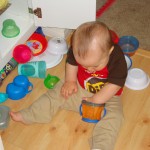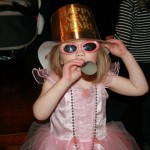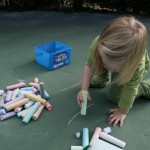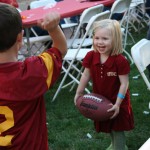As a pediatric physical therapist and a mom, I have played with many toys! When I became a school therapist, I no longer had the luxury of being able to choose from many toys in many shapes and sizes. Instead, my therapy “equipment” had to fit in the trunk of my Toyota Corolla. I needed to have toys that were multi-functional, portable, and loads of fun.
As the years have passed, it seems harder to find these toys. Toy manufacturers are making more toys that are either: one trick ponies, overstimulating, or oversized. Perhaps it is becoming a bit too much? With the ever expanding influence of electronic media, our children spend more of their time being passively entertained by or minimally interacting by way of an electronic device. Today’s toys use onboard computers that dictate the play experience. This robs children of both unstructured play with friends and individual creative play.
A child’s job is to play. That is how they learn about themselves and their environment. A child’s natural curiosity facilitates learning from play. It is what childhood is all about. Toys can be “tools” to help a child grow physically, mentally, and socially. But, with so many toy options out there between the big toy stores, deal sites, and Amazon, how do you know what toy would be the best choice? Sure, you could read the list of reviews but here is another option. The American Occupational Therapy Association has put together a Checklist for Toy Shopping, which lists questions to consider before purchasing a toy. The Top 5 Questions that I use as a mom and a PT are listed below:
1.) Can the toy be played with in more than one way?

Building toys (blocks, bristle blocks, tinker toys) encourage creativity, problem solving, and also focus on fine motor skills and hand strengthening. Stacking cups are another great option. This simple toy can be used to build, hide, scoop/pour, put in/take out. In fact, this link provides 20 different ways to use stacking cups.
Think about some things that you may have used as toys when you were little! Tupperware, pots/pans, and cardboard boxes all inspire imaginative play in your little one for a fraction of the cost of many fancy toys on the market today. Stacking cups, measuring cups, Tupperware, and pots/pans can move from a play kitchen to the bath tub! You can “bake” many yummy items in the bath tub with cups and bowls and it also reinforces activities such as pouring/mixing (ingredients), counting (cups of flour), etc.
2.) Does the toy appeal to more than one sense?

We want the child to be drawn to a toy and to remain interested. Often, bright colors, lights, music, and textures will do just that. However, be cautious not to provide too much stimulation! A toy that provides too much can have the adverse effect of shut down or disinterest. Instead of your child pushing a button and hearing music, consider musical instruments. They are portable, encourage rhythm and imagination. Helpful hint: if you do have a toy that is too loud, try placing tape over the speaker to dampen the sound.
3.) Can the toy be used in more than one place?

Consider items such as crayons, write on boards, stickers, and small steno pads carried in a small bag for trips to restaurants, etc. Toys like wood puzzles and magnet toys (animals, letters, etc.) can also be moved from room to room. I have used magnet toys for many different activities as well. Remember, you can always use a cookie sheet to stick the magnets to if a metal surface isn’t always nearby.
4.) Can the toy be used in more than one position?

Play mats are great for tummy time but also for practicing side lying and for reaching up in supine. Books can often be read in more than one position. It is often a wonderful idea to encourage our children to read, write, and color on their tummies (strengthens neck and back muscles while providing shoulder and forearm stability) since most of their day is spent upright in sitting, standing, and playing!
5.) Does the toy encourage activity and movement?

As a pediatric physical therapist, I love toys that encourage movement. Yet, if you think about it, you can make many toys encourage movement. Think about using bean bags, puzzle pieces, blocks, or stickers as a means to encourage physical activity with your child. Set up puzzle pieces at one end of the room and the puzzle board on another. Have your child do a different animal walk to retrieve each puzzle piece! Side walk chalk can be used to draw hopscotch boards, obstacle courses instead of simply drawing! Bean Bags serve as wonderful items to search for in a scavenger hunt!
Consider the “old school” toys for encouraging movement as well: balls, jump ropes, riding toys. With movement, encourage use of the arms and legs to build strength in the large muscle groups but also to work on developing balance and coordination. Jump ropes can be used as snakes to jump over and lines to walk along!
In the end, make sure that the toy is developmentally appropriate for your child to prevent frustration and encourage independence. In therapy, we often work to find the “just right challenge” – making the activity challenging enough to foster growth but does not overwhelm them or cause frustration. Choosing the right tools for play is so important. Hopefully the checklist and ideas provided have helped you begin looking at toys in a new way and have allowed you to become more excited about the role of toys and play as your child moves, plays, and grows!
